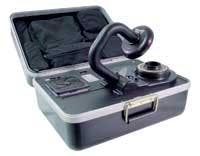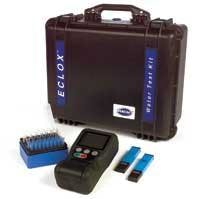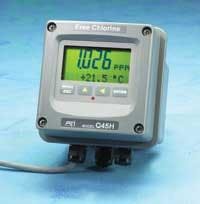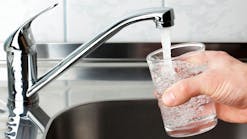Editor’s Note: EPA offers a series of on-line water security product guides. Much of the information for this article was drawn from those guides. The on-line resource can be found at http://www.epa.gov/safewater/watersecurity/guide/water
Many of the same monitoring systems used by utilities to comply with the Safe Drinking Water Act and Clean Water Act can also be used for water security monitoring - helping identify sudden changes in water quality that could indicate a threat to water safety. A variety of new technologies are also coming on the market.
Some sensors, such as sensors for biological organisms or radiological contaminants, measure potential contamination directly, while others, particularly some chemical monitoring systems, measure “surrogate” parameters that may indicate problems in the system but do not identify sources of contamination directly.
Chemical sensors that can be used to identify potential threats to water systems include inorganic monitors (chlorine analyzers), organic monitors (total organic carbon analyzers) and toxicity meters. Radiological meters can be used to measure concentrations of several different radioactive species. Monitors that use biological species also can be used as sentinels for the presence of contaminants of concern, such as toxics.
Monitoring can be conducted using either portable or fixed-location sensors. Fixed-location sensors are typically used as part of a continuous, on-line monitoring system. Continuous monitoring has the advantage of providing immediate notification when there is an upset. However, the sampling points are fixed and only certain points in the system can be monitored. In addition, the number of monitoring sites needed to capture the physical, chemical, and biological complexity of a system can be prohibitive.
Chlorine Measurement Systems
Residual chlorine levels in a system can serve as a surrogate for detecting potentially threatening contamination, because many chemical and biological contaminants are known to combine with chlorine. Therefore, a significant decline or loss of residual chlorine could be an indication of potential threats to the system.
Chlorine residuals can be measured using continuous on-line monitors at fixed points in the system, or by taking grab samples at any point in the system and using chlorine test kits or portable sensors to determine chlorine concentrations.
Correct placement of residual chlorine monitoring points within a system is crucial to early detection of potential threats. Monitoring points and monitoring procedures for SDWA compliance vs. system security may be different, and utilities must determine the best use of on-line, fixed monitoring systems vs. portable sensors/test kits to balance their SDWA compliance and security needs.
When testing for security using chlorine residual, a gross change is the best indicator of a potential threat. Therefore, high-sensitivity probes are not really required for security testing. Chlorine concentrations ranging from 0.5 to 2.0 mg/L are typically required for drinking water monitoring applications, and deviations from this range should be sufficient to identify security threats. Both colorimetric and electrode technologies can detect free or total chlorine to hundredths of a milligram per liter. Linearity of response in the range of 0.5 percent with repeatability of 0.05 mg/L can be expected.
It should be noted that not all potential contaminants react with chlorine. One of the key areas of concern with reliance on chlorine residual is microbial adaptation under potable water treatment conditions or within conveyance systems. Contaminants known to be resistant to chlorine disinfection include Anthrax bacteria, T-2 Mycotoxin biotoxin, Microcystins biotoxin, Ricin biotoxin and Cryptosporidiosis protozoan.
Some of the companies offering chlorine analyzers that might be applied to security monitoring include Hach, Teledyne Isco, Analytical Technology Inc. and Chemetrics.
TOC Analyzers
Total Organic Carbon (TOC) analysis is a well-defined and commonly used method that measures the carbon content of dissolved and particulate organic matter present in water. For security monitoring, measuring changes in TOC concentration can be an effective surrogate for detecting contamination from organic compounds (e.g. petrochemicals, solvents, pesticides). While TOC analysis does not give specific information about the nature of the threat, identifying changes in TOC can be a good indicator of potential threats to a system.
TOC analysis consists of inorganic carbon removal, oxidation of the organic carbon into CO2, and quantification of the CO2. The primary differences between various on-line TOC analyzers are in the methods used for oxidation and CO2 quantification. While the differences in analytical methods may be important in compliance or process monitoring, high levels of precision and the ability to distinguish specific organic fractions from a sample may not be required for detection of a potential chemical threat. Because TOC concentrations are simply surrogates that can indicate potential problems in a system, gross changes are the best indicators of potential threats.
The response time of a TOC analyzer may vary depending on the manufacturer’s specifications, but it usually takes from 5 to 15 minutes to get a stable, accurate reading.
On-line TOC analyzers are designed to operate in remote locations without continuous surveillance by an operator. However, to operate reliably, the instruments require regular calibration, inspection, and maintenance by technically skilled personnel. Previous research recommends that, at a minimum, a weekly check should be done if the analyzer is in a remote location.
Some of the companies offering TOC analyzers that might be applied to security monitoring include Hach, Teledyne Isco and Shimadzu.
Toxicity Monitoring/Toxicity Meters
Toxicity measurement devices measure general toxicity to biological organisms, and detection of toxicity in any water/wastewater asset can indicate a potential threat, either to the treatment process (in the case of influent toxicity), to human health (in the case of finished drinking water toxicity) or to the environment (in the case of effluent toxicity).
The ability to get feedback on sample toxicity from short-term toxicity tests or toxicity “meters” can be valuable in estimating the overall toxicity of a sample. On-line real time toxicity monitoring is under active research and development. However, there are several portable toxicity measurement devices commercially available. They can generally be divided into Biological and Chemical sensors based on the different ways they measure toxicity.
Biological Sensors for Toxicity
Toxicity tests measure water toxicity by monitoring adverse biological effects on test organisms. Toxicity tests have traditionally been used to monitor wastewater effluent streams for NPDES permit compliance or to test incoming wastewater samples for toxicity. However, this technology can also be used to monitor drinking water distribution systems.
Currently, several types of bio-sensors and toxicity tests are being adapted for use in the water security field. The keys to using bio-monitoring or bio-sensors for drinking water security are rapid response and the ability to use the monitor at critical locations in the system, such as in water distribution systems downstream of pump stations.
While there are several different organisms that can be used to monitor for toxicity (including bacteria, invertebrates, and fish), bacteria-based bio-sensors are ideal for use as early warning screening tools for drinking water security because bacteria usually respond to toxics in a matter of minutes. In contrast, methods using higher-level organisms such as fish may take several days to produce a measurable result.
Bacteria-based bio-sensors have recently been incorporated into portable instruments, making rapid response and field-testing practical. These portable meters detect a decrease in biological activity, which can be correlated with increased levels of toxicity.
An example is the Microtox® toxicity test system from Strategic Diagnostics Inc. The system is based on the use of luminescent bacteria to measure toxicity from environmental samples. Bacterial bioluminescence is tied directly to cell respiration, and any inhibition of cellular activity (toxicity) results in a decreased rate of respiration and a corresponding decrease in the rate of luminescence. The more toxic the sample, the greater the percent light loss from the test suspension of luminescent bacteria. The system can be used for identifying an increase in toxicity or biomass that would be characteristic of the intentional contamination of a water supply.
Hach Homeland Security Technologies recently began offering for sale a kit that combines the Eclox chemiluminescence toxicity method with other water quality tests, creating a new field test kit designed to meet the recommendations of the USEPA in its emergency response protocols. The Hach Eclox Test Kit includes tests for on-site measurement of pH, total dissolved solids (TDS), free and total chlorine, and color, plus screening tests for pesticide/nerve agents and arsenic.
Chemical Sensors for Toxicity
One manufacturer has adapted a BOD analyzer to measure oxygen consumption as a surrogate for general toxicity - the ISCO / STIPTOX Adapt W Toximeter. The critical element in the analyzer is the bioreactor, which is used to continuously measure the respiration of the biomass under stable conditions. As the toxicity of the sample increases, the oxygen consumption in the sample decreases. An alarm can be programmed to sound if oxygen reaches a minimum concentration (i.e., if the sample is strongly toxic). The operator must then interpret the results into a measure of toxicity.
Emerging Technologies
There are a variety of new technologies under development or being offered for use in drinking water security.
One example is the Idaho Technology Inc. (ITI) Ruggedized Advanced Pathogen Identification Device (R.A.P.I.D.®) System, which can detect anthrax, Brucella, plague, E coli, Salmonella, cryptosporidium and other potential biological agents. The portable laboratory system works by identifying organisms through their unique genetic signature. For instance, the DNA from salmonella bacteria is different from the DNA of smallpox virus. The system reads those differences and reports results within 15 to 25 minutes. The system is automated and can be operated with minimal training.
JMAR Technologies Inc. recently entered into an agreement to test Beta models of its BioSentry waterborne microorganism monitoring system with the Olivenhain Municipal Water District (OMWD). OMWD, near San Diego, CA, will use three of the biological detection units to continuously monitor the purity of water at various points in its treatment plant. The BioSentry is a laser-based early-warning system designed to monitor, detect and classify waterborne microorganisms in real time.
Beta model BioSentry units will be positioned in the plant to monitor raw influent water, treated effluent water, and distribution system water.





